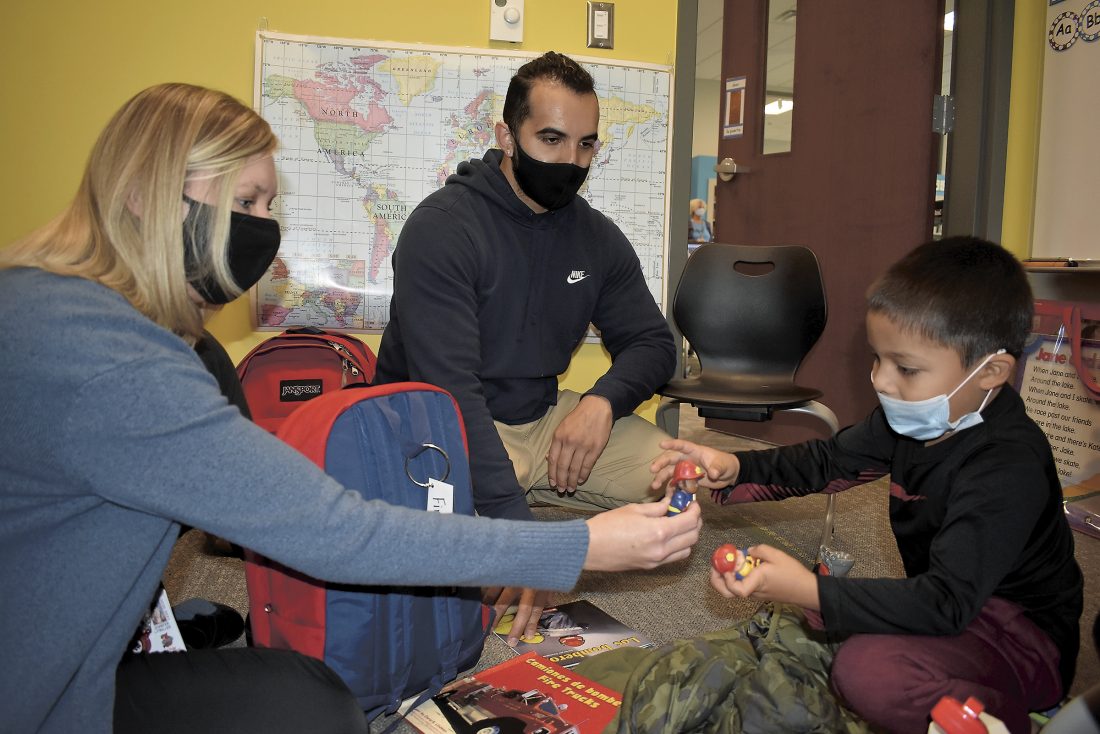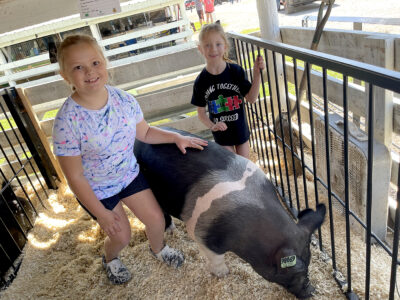Bringing the learning home
ELL backpacks help students, families grow together
-
-Messenger photo by Chad Thompson
Jenny Litwiller, English Language Learner teacher in the Fort Dodge Community School District, left, shares some firefighter toys with Bryan Perez, 5, a kindergarten student at Duncombe Elementary School, on Wednesday. The toys are included in ELL backpacks that Litwiller distributes to students who are learning English as a second language. The materials in the backpacks contain toys and activities to help students learn both English and Spanish. Angel Medina, ELL tutor, looks on.
-
-Messenger photo by Chad Thompson
Bryan Perez, 5, a kindergarten student at Duncombe Elementary School, flips through the pages of an English Language Learner fire engine book. The book contains both English and Spanish text.
-
-Messenger photo by Chad Thompson
Bryan Perez, 5, a kindergarten student at Duncombe Elementary School, looks over a ladder truck that was included in an English Language Learner backpack. Jenny Litwiller, ELL teacher in the Fort Dodge Community School District, has distributed about 15 backpacks for students who are learning English as a second language.
- -Messenger photo by Chad Thompson Bryan Perez, 5, a kindgarten student at Duncombe Elementary School, has his ELL backpack ready to go on Wednesday at the school.

-Messenger photo by Chad Thompson
Jenny Litwiller, English Language Learner teacher in the Fort Dodge Community School District, left, shares some firefighter toys with Bryan Perez, 5, a kindergarten student at Duncombe Elementary School, on Wednesday. The toys are included in ELL backpacks that Litwiller distributes to students who are learning English as a second language. The materials in the backpacks contain toys and activities to help students learn both English and Spanish. Angel Medina, ELL tutor, looks on.
Jenny Litwiller, a teacher who specializes in English Language Learning, asked kindergarten student Bryan Perez who was going to read to him tonight.
“My papa,” said Perez, 5, on Wednesday at Duncombe Elementary School.
Reading to Perez at home will be made easier thanks to an ELL backpack that Litwiller gave to the boy. Perez’s parents are literate in Spanish. The materials inside the backpack contain books, games and activities with both English and Spanish words.
The backpacks have a wide range of themes and learning activities that span K-4 learning. All of the backpacks contain at least one book, but many of them come with several books about a specific topic.
The backpack Perez got on Wednesday had the theme of firefighting. It came with a fire engine book and a couple fire engine toys. It didn’t take long for Perez to unfold the ladder on the toy truck.

-Messenger photo by Chad Thompson
Bryan Perez, 5, a kindergarten student at Duncombe Elementary School, flips through the pages of an English Language Learner fire engine book. The book contains both English and Spanish text.
“Maybe you’ll be a firefighter someday,” Litwiller said. “You can teach your family about firefighting.”
Perez nodded in approval.
“This one (book) talks a lot about fire safety and has a lot of both English and Spanish words,” Litwiller said.
It’s already the second backpack Perez has received this school year. The first one had a numbers theme.
“That one had numbers and counting,” Litwiller said. “After he took the numbers backpack home in September, we have seen a big improvement in numbers and counting.”

-Messenger photo by Chad Thompson
Bryan Perez, 5, a kindergarten student at Duncombe Elementary School, looks over a ladder truck that was included in an English Language Learner backpack. Jenny Litwiller, ELL teacher in the Fort Dodge Community School District, has distributed about 15 backpacks for students who are learning English as a second language.
She said the numbers bag focused specifically on the numbers 1 through 5.
Perez is one of 42 ELL students in the Fort Dodge Community School District elementary schools. The majority of ELL students attend Duncombe, including all of the beginners.
In addition to Duncombe, Litwiller visits Butler and Cooper elementary schools to serve students every week.
She is confident the backpacks will benefit the ELL students she serves.
Litwiller is part of an ELL group that formed about two years ago. It’s made up of teachers from the elementary schools, middle school and high school.

-Messenger photo by Chad Thompson Bryan Perez, 5, a kindgarten student at Duncombe Elementary School, has his ELL backpack ready to go on Wednesday at the school.
“This was one of the ideas we had for younger students to engage families with some bilingual books,”she said. “It’s hard if they bring home books that are only in English. This is a way to bridge that disconnect.”
Litwiller said the goal is for students to develop strong skills in both English and Spanish.
“This sends a message that it’s an asset to be bilingual and that all cultures are accepted and respected in Fort Dodge schools,” she said. “We want students to keep their first language.”
Litwiller’s career in education spans 20 years. Most of her experience has been with private preschools and Head Start.
She became an ELL teacher within the FDCSD about four years ago. Litwiller holds endorsements in early childhood, elementary and English as a Second Language.
“It’s neat because a lot of kids I have now I had in preschool,” Litwiller said. “I’ve loved watching them grow and learn to speak English and (families) become more involved in the community.”
Litwiller said she likes to keep students in the regular classroom setting for the most part.
“My job is to support ELL students and their classroom teachers with gaining English proficiency,” she said. “Mostly, I try to support the students during regular core curriculum. Sometimes we form small groups when we are working on a specific language skill.
“For the most part, we try to go into (regular classroom) because we want kids with their peers as much as possible. They learn quickly and are building friendships.”
She said teaching subjects together is a good idea.
“Teaching language and teaching math aren’t separate,” she said. “They can be taught together and we want to teach them together.”
Perez, Litwiller said, has been learning fast.
“He’s just soaking everything up,” Litwiller said. “I love to see it.”
She said Perez has older siblings who read and write in English. His parents are primarily Spanish-speaking.
“So they will like to do something with him that they can use their native language,” Litwiller said. “(Perez) can learn more vocabulary in his native language as well as in English. Whoever is playing with the student should be able to interact with them at home.”
So far, Litwiller has distributed about 15 different backpacks. She has about 25 total.
The backpacks are used by the families for about two weeks before being returned. Staff then cleans the materials before another family gets them.
The materials were primarily funded through Title III ELL funding.
Litwiller also received multiple free books from the nonprofit First Book.
Litwiller credits her colleagues for helping ELL students.
“All of my co-workers are great about sharing materials and anything bilingual that we can pass on to families,” she said.
Litwiller said communication with families has been more challenging during the COVID-19 pandemic.
“It’s more important now than ever to make these connections with families (with more learning being accomplished virtually),” she said. “To bring the learning from here to inside their homes is powerful.”








